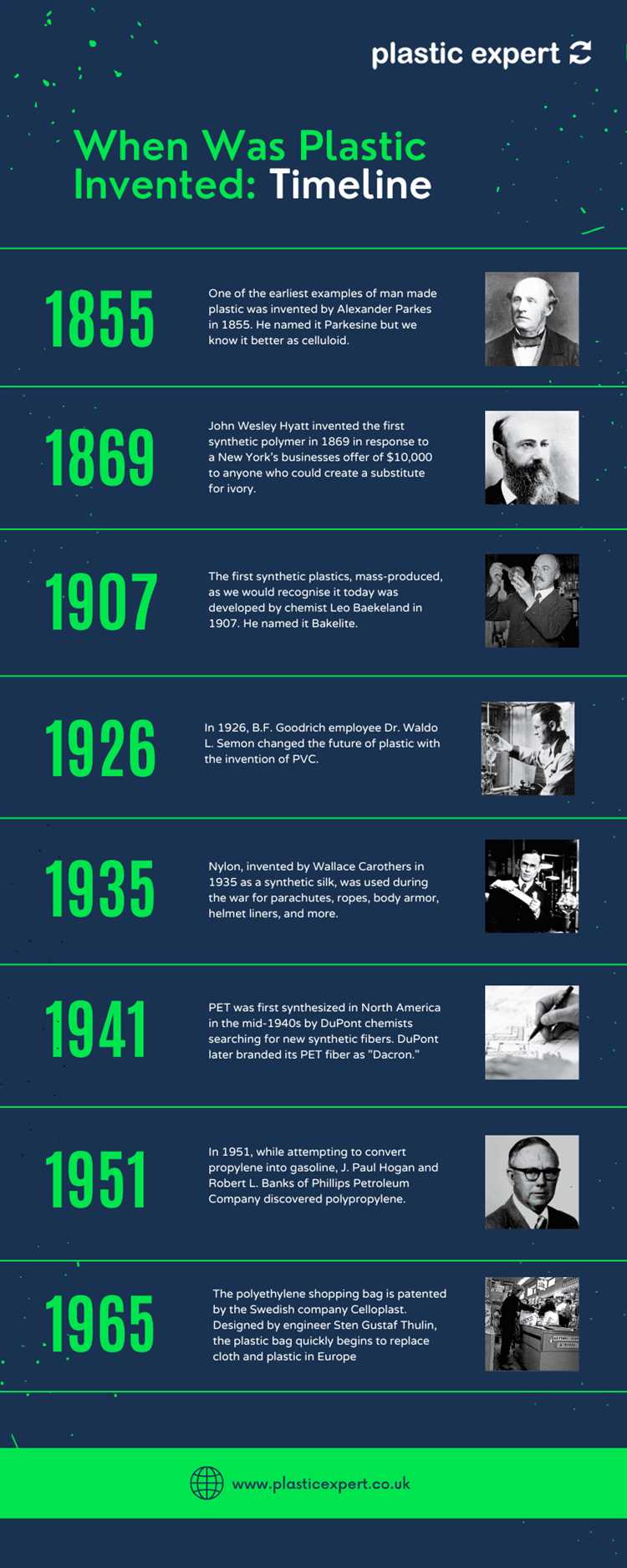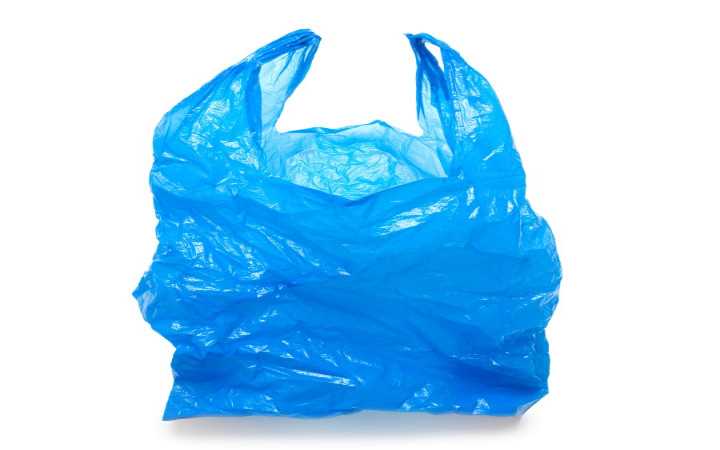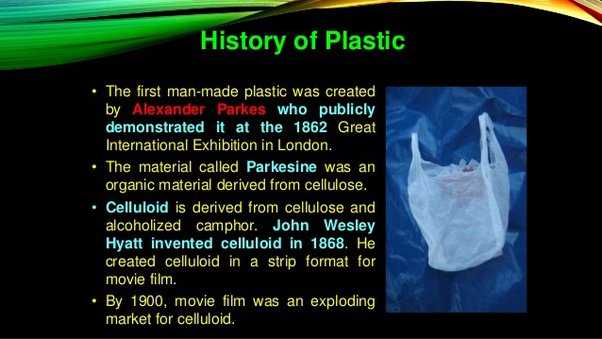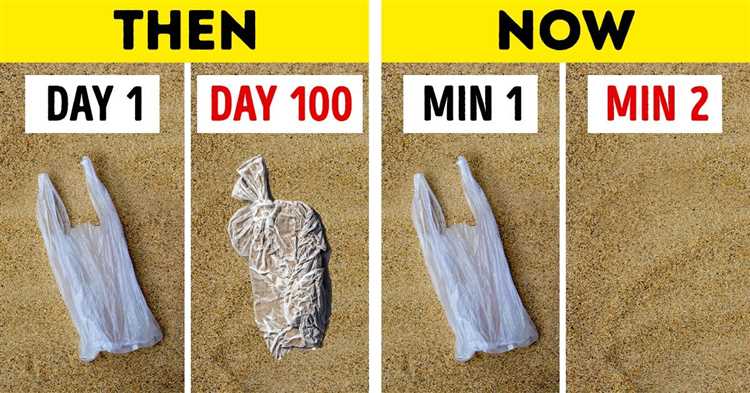
Plastic is an essential material in our modern world, used in everything from packaging to electronics to construction. But have you ever wondered who invented plastic? The origins of this revolutionary material can be traced back to the 19th century, when a brilliant inventor named Alexander Parkes made a groundbreaking discovery.
Alexander Parkes was born in Birmingham, England in 1813. From a young age, he showed a keen interest in science and engineering. In the 1840s, Parkes began experimenting with a substance he called “Parkesine.” This was the first form of plastic ever created, and it was made from a combination of organic materials and cellulose.
Parkesine was a significant breakthrough, as it could be molded into various shapes when heated and then cooled. It was also durable, lightweight, and resistant to water. These properties made it an ideal substitute for materials like ivory and tortoiseshell, which were becoming increasingly scarce and expensive.
Although Parkesine was a remarkable invention, it wasn’t until 1907 that the word “plastic” was officially coined. This term came from the Greek word “plastikos,” which means “capable of being shaped or molded.” The invention of Parkesine paved the way for the development of other types of plastics, such as celluloid and Bakelite, which revolutionized industries around the world.
- The Revolutionary Material: The Origin of Plastic
- Early Beginnings
- Advancements and Modern Plastic
- The Predecessors: Early Development of Synthetic Materials
- The Inventor’s Journey: A Profile of the Revolutionary Mind
- The Breakthrough Discovery: Uncovering the Birth of Plastic
- The Impact on Industries: Transforming Manufacturing Processes
- The Ecology Paradox: Plastic’s Environmental Consequences
- The Future of Plastic: Innovations and Sustainability Solutions
- Question-answer:
- Who invented plastic?
- What were the first plastics made from?
- How did the invention of plastic revolutionize industries?
- What are some of the key uses of plastic today?
- What are the environmental impacts of plastic?
- Who is credited with inventing plastic?
The Revolutionary Material: The Origin of Plastic

Plastic has undoubtedly revolutionized countless industries and become an integral part of our daily lives. But how did this extraordinary material come to be?
Early Beginnings
The origins of plastic can be traced back to the mid-19th century when a young inventor named Alexander Parkes stumbled upon a groundbreaking discovery. Parkes was searching for a substitute for ivory, a material in high demand at the time. Through his experimentation, he developed a material known as Parkesine, which is considered to be the first man-made plastic.
Parkesine was derived from cellulose, a natural polymer found in plant cell walls. Parkes discovered that by treating cellulose with nitric acid, he could create a substance that could be molded into various shapes while retaining its durability. This new material proved to be a valuable alternative to ivory, offering similar properties but without the ethical and environmental concerns.
Advancements and Modern Plastic

Following Parkes’ invention, the field of plastic manufacturing saw significant advancements. During the early 20th century, chemists such as Leo Baekeland and Wallace Carothers made groundbreaking discoveries that paved the way for more versatile and commercially viable plastics.
One of the most notable advancements came with the invention of Bakelite by Leo Baekeland in 1907. Bakelite was the first synthetic plastic made from a combination of phenol and formaldehyde. It could be molded and shaped easily, and its heat resistance and electrical non-conductivity made it a valuable material for various industries, including electrical and automotive.
Since then, countless varieties of plastics have been developed, each with unique properties and applications. Plastics have revolutionized industries such as packaging, transportation, healthcare, and electronics, just to name a few.
Plastic’s immense popularity can be attributed to its versatility, durability, and cost-effectiveness. However, it is important to note that plastic waste has also become a significant environmental concern. The durability of plastic means it can take hundreds of years to degrade, leading to pollution and harming ecosystems.
In recent years, there has been a growing focus on developing more sustainable alternatives to traditional plastics. Innovations such as biodegradable plastics and plant-based polymers offer hope for a more environmentally friendly future.
Overall, the invention and evolution of plastic have had an undeniable impact on our modern world. From its humble beginnings as a substitute for ivory, plastic has transformed industries, improved lives, and posed new challenges for our planet.
The Revolutionary Material: The Origin of Plastic
The invention of plastic and its continuous development has shaped the way we live, work, and consume. While there are challenges ahead, the possibilities for plastic’s future remain vast and ever-evolving.
The Predecessors: Early Development of Synthetic Materials
In the quest to create and perfect plastic, inventors have looked to the past for inspiration. Synthetic materials have a long history, with early precursors laying the foundation for the development of the revolutionary material we know today as plastic.
One important predecessor of plastic is celluloid. Developed in the mid-19th century, celluloid was the first synthetic material to be mass-produced. It was made from a combination of cellulose, a substance derived from plant fibers, and camphor, a natural product derived from tree bark. Celluloid quickly gained popularity as a substitute for expensive materials like ivory and tortoiseshell, and was used to make a variety of products such as combs, buttons, and photographic film.
Another key predecessor of plastic is Bakelite, which was invented in the early 20th century by Belgian-born chemist Leo Baekeland. Bakelite was the first synthetic plastic, and it revolutionized the world of manufacturing. Baekeland discovered that by reacting phenol with formaldehyde, he could create a durable, heat-resistant material that could be molded into a wide range of shapes. Bakelite became a popular material for electrical insulation, telephones, and consumer goods, and its success paved the way for further advancements in plastic technology.
Polyvinyl chloride (PVC) is yet another important predecessor of plastic. Developed in the early 20th century, PVC quickly became a popular material for a wide range of applications due to its versatility and durability. It is made by polymerizing vinyl chloride molecules to create a rigid and durable material. PVC is used in a variety of products today, including pipes, clothing, and vinyl records.
These early developments in synthetic materials paved the way for the creation of modern plastics. By building upon the knowledge and techniques of their predecessors, inventors were able to push the boundaries of what was possible and revolutionize numerous industries. Today, plastic is an essential component of our everyday lives, thanks to the groundbreaking work of those who came before.
| Material | Inventor | Year |
|---|---|---|
| Celluloid | Alexander Parkes | 1856 |
| Bakelite | Leo Baekeland | 1907 |
| PVC | Ivan Ostromislensky | 1913 |
The Inventor’s Journey: A Profile of the Revolutionary Mind
Throughout history, there have been individuals whose brilliant ideas and innovative thinking have reshaped entire industries. The inventor of plastic stands among these pioneers, forever changing the way we live and interact with the world. Their journey was one of determined persistence and unwavering commitment to their vision.
From a young age, the inventor demonstrated an insatiable curiosity about the natural world. They spent countless hours exploring their surroundings, observing the behavior of plants and animals, and conducting their own experiments. This early fascination with science and the mysteries of the universe laid the foundation for their future breakthroughs.
As they grew older, the inventor’s passion for knowledge only deepened. They devoured books on chemistry, physics, and engineering, absorbing every bit of information they could find. It was during this time that they began to envision a material that could be molded into any shape and have multiple uses. This idea would become the driving force behind their lifelong pursuit of the invention we now know as plastic.
The inventor faced numerous challenges along the way. Many people dismissed their ideas as impractical or unrealistic. Some even ridiculed their relentless pursuit, calling them a dreamer or a fool. But the inventor remained undeterred, fueled by a belief in their vision and an unwavering belief in the power of their ideas.
Years of experimentation and countless failed attempts followed. The inventor dedicated themselves to perfecting their formula, tirelessly searching for the right combination of materials and processes. They worked tirelessly in their lab, often sacrificing sleep and social engagements in the pursuit of their goal.
- One by one, breakthroughs began to emerge.
- First, a material that was flexible yet durable.
- Then, a substance that could be adapted for various applications.
- Finally, a synthetic polymer that could be mass-produced.
This was the moment the inventor had been waiting for – the realization of their vision. Plastic had arrived, and the world would never be the same.
The legacy of the inventor of plastic is one of resilience and innovation. They dared to dream big and think outside the box, forever changing the possibilities of what could be created. Their journey serves as a reminder to us all that with determination and perseverance, anything is possible.
The Breakthrough Discovery: Uncovering the Birth of Plastic
In the late 19th century, a pivotal breakthrough occurred in the world of material science that would change human history forever. This breakthrough involved the discovery and development of plastic, a revolutionary material that would go on to shape countless industries and aspects of our daily lives.
The credit for this groundbreaking discovery goes to a brilliant chemist named Alexander Parkes. In 1855, Parkes patented a process for creating a new material that he called “Parkesine,” which was the world’s first thermoplastic.
Parkesine was made by dissolving cellulose in a mixture of alcohol and camphor, and then shaping it into various forms. This material had many desirable qualities. It was lightweight, easy to mold, and could be translucent or colored. Its versatility and durability made it a suitable replacement for expensive materials like ivory, rubber, and even metal.
The introduction of Parkesine was met with great excitement and quickly gained popularity. It was used in a wide range of applications, including buttons, combs, jewelry, and even clothes. Parkesine proved to be a game-changer, offering a cost-effective and practical alternative to the traditional materials of the time.
Although Parkesine was a significant advancement, it had its limitations. It was highly flammable and prone to cracking and shrinking over time. However, this did not deter scientists and inventors from building upon Parkes’ work.
It was not until the early 20th century that the development of modern plastics truly took off. Innovators such as Leo Hendrik Baekeland and his creation of Bakelite, the world’s first synthetic plastic, paved the way for the explosive growth of the plastic industry.
Today, plastic has become an integral part of our world. It is used in everything from packaging materials to medical devices, from electronics to construction materials. Plastic’s immense importance and widespread use can be traced back to the breakthrough discovery made by Alexander Parkes over a century and a half ago.
In conclusion, Alexander Parkes’ invention of Parkesine was the pivotal moment in the birth of plastic. His groundbreaking discovery laid the foundation for the development of modern plastics, which continue to revolutionize our lives in ways unimaginable to our ancestors.
The Impact on Industries: Transforming Manufacturing Processes
Plastic, the revolutionary material invented by [Inventor’s Name], has had a profound impact on various industries, transforming manufacturing processes and revolutionizing the way products are made.
One of the key advantages of plastic is its versatility. Unlike traditional materials like wood or metal, plastic can be molded into any shape and size, making it ideal for intricate designs and complex manufacturing techniques. This flexibility has allowed industries such as automotive, electronics, and packaging to innovate and create products that were previously unimaginable.
With plastic, manufacturers can produce lightweight yet durable components, reducing the overall weight of products. This has been particularly beneficial in the transportation industry, where lightweight materials help improve fuel efficiency and reduce emissions.
Plastic’s resistance to corrosion and chemicals has also transformed manufacturing processes in the chemical and pharmaceutical industries. It allows for the safe storage and transport of chemicals and pharmaceutical products, ensuring their integrity throughout the supply chain.
Moreover, plastic’s affordability has made it accessible to a wide range of industries, enabling mass production and decreasing manufacturing costs. This has revolutionized the consumer goods industry, where plastic is used in everything from appliances to toys, making products more affordable and accessible to consumers.
The use of plastic has also had a significant environmental impact on industries. While there are concerns about plastic waste and its impact on the environment, advancements in recycling and sustainability have emerged. Manufacturers are now developing new ways to recycle and reuse plastic, reducing the amount of waste generated and promoting a more sustainable approach to manufacturing.
In summary, the invention of plastic has had a transformative effect on industries, revolutionizing manufacturing processes and enabling innovation in various sectors. As technology continues to advance, it is likely that plastic will play an even more significant role in shaping the future of industries worldwide.
The Ecology Paradox: Plastic’s Environmental Consequences

One of the key issues with plastic is its longevity. Unlike natural materials, which can decompose over time, plastic can take hundreds of years to break down. This means that the plastic waste we generate today will continue to exist for generations to come, polluting our land, rivers, and oceans.
Another major consequence of plastic is its impact on wildlife. Plastic pollution is responsible for the death of thousands of marine animals each year. Birds, sea turtles, and fish often mistake plastic debris for food and end up choking or suffocating as a result. This not only disrupts ecosystems but also threatens the survival of many species.
Furthermore, the production of plastic itself contributes to environmental degradation. Plastics are typically made from fossil fuels, resulting in the release of greenhouse gases that contribute to climate change. Additionally, the production process consumes significant amounts of water and energy, further exacerbating our already strained resources.
The use of plastic also contributes to the depletion of natural resources. As the demand for plastic products continues to rise, more and more raw materials are needed, leading to deforestation and the destruction of habitats. This not only threatens the biodiversity of ecosystems but also affects the livelihoods of indigenous communities who rely on these resources.
In conclusion, while plastic has undoubtedly brought immense convenience and innovation to our lives, its environmental consequences cannot be ignored. As consumers and manufacturers, it is crucial for us to find sustainable alternatives and adopt responsible practices to mitigate the ecological paradox that plastic presents. The future of our planet depends on it.
The Future of Plastic: Innovations and Sustainability Solutions

Plastic has undoubtedly revolutionized a wide range of industries, but its impact on the environment has also been a cause for concern. As we look towards the future, it’s imperative that we find sustainable solutions to reduce the negative effects of plastic on our planet.
One of the key areas of focus for the future of plastic is innovation in material development. Researchers and scientists are exploring new ways to create plastics that are eco-friendly and biodegradable. These materials could replace traditional plastics and reduce the amount of waste that ends up in landfills and oceans.
Bioplastics are one such innovative solution. Derived from renewable sources such as plants, these plastics not only reduce carbon emissions during production but also decompose more easily in the environment. Companies are actively investing in research and development to make bioplastics a viable alternative to traditional plastics.
Recycling is another critical aspect of the future of plastic. Efforts are being made to improve recycling technologies and expand infrastructure to ensure that more plastics are recycled rather than being disposed of. Additionally, advancements in recycling processes are allowing for the recycling of previously non-recyclable plastics, further reducing waste and resource consumption.
Plastic pollution in the oceans is a pressing issue, and efforts are being made to develop innovative cleanup technologies. From ocean cleanup vessels to floating screens that collect plastic waste, various organizations and startups are working on solutions to remove plastic debris from marine environments.
Beyond material innovations and recycling improvements, reducing plastic consumption is essential for a sustainable future. Many initiatives are underway to encourage individuals and businesses to use less plastic, such as implementing plastic bag bans, promoting reusable alternatives, and raising awareness about the environmental impact of plastic.
The future of plastic also lies in responsible waste management. Implementing efficient waste management systems can ensure that plastic waste is properly collected, sorted, and processed. This includes proper disposal of non-recyclable plastics and the development of advanced technologies for waste-to-energy conversion, minimizing the environmental impact of plastic waste.
Overall, the future of plastic depends on a comprehensive and multi-faceted approach. While innovation in materials, recycling, and waste management plays a vital role, individual actions and collective efforts are equally important to create a more sustainable and environmentally conscious future.
Question-answer:
Who invented plastic?
Plastic was invented by Alexander Parkes, an English chemist, in 1855.
What were the first plastics made from?
The first plastics were made from cellulose, a plant-based material.
How did the invention of plastic revolutionize industries?
The invention of plastic revolutionized industries by providing a versatile, lightweight, and inexpensive material that could be molded into various shapes, leading to the development of new products and improved manufacturing processes.
What are some of the key uses of plastic today?
Plastic is used in a wide range of industries and products, including packaging, construction materials, electronics, automotive parts, and medical devices.
What are the environmental impacts of plastic?
Plastic has significant environmental impacts, including pollution of oceans and landfills, harm to wildlife, and contribution to greenhouse gas emissions during production and disposal. Efforts are being made to reduce plastic waste and develop more sustainable alternatives.
Who is credited with inventing plastic?
Plastic was not invented by a single individual. It was a collective effort by several scientists and inventors. However, Leo Hendrik Baekeland is widely recognized as the father of modern plastics for his invention of Bakelite, the first synthetic plastic.